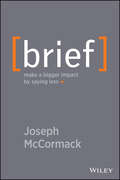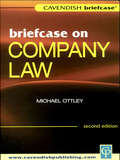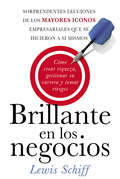- Table View
- List View
Brief Note on Portraying HBS Case Protagonists
by Anthony J. Mayo Alexandra C FeldbergIndustry and Background Note
Brief Note on Social Motives
by John J. Gabarro Wallace WormleyBriefly describes in management terms the three social motives: Need for achievement; need for power; need for affiliation. Also briefly reviews the implications of the work of David McClelland, David Winters, and others for motivation within organizational settings. The power motive is described in terms of both "personalized power" and "socialized power."
Brief: Make a Bigger Impact by Saying Less
by Joseph McCormackGet heard by being clear and concise The only way to survive in business today is to be a lean communicator. Busy executives expect you to respect and manage their time more effectively than ever. You need to do the groundwork to make your message tight and to the point. The average professional receives 304 emails per week and checks their smartphones 36 times an hour and 38 hours a week. This inattention has spread to every part of life. The average attention span has shrunk from 12 seconds in 2000 to eight in 2012. So, throw them a lifeline and be brief. Author Joe McCormack tackles the challenges of inattention, interruptions, and impatience that every professional faces. His proven B.R.I.E.F. approach, which stands for Background, Relevance, Information, Ending, and Follow up, helps simplify and clarify complex communication. BRIEF will help you summarize lengthy information, tell a short story, harness the power of infographics and videos, and turn monologue presentations into controlled conversations. Details the B.R.I.E.F. approach to distilling your message into a brief presentation Written by the founder and CEO of Sheffield Marketing Partners, which specializes in message and narrative development, who is also a recognized expert in Narrative Mapping, a technique that helps clients achieve a clearer and more concise message Long story short: BRIEF will help you gain the muscle you need to eliminate wasteful words and stand out from the rest. Be better. Be brief.
Briefcase on Company Law (Briefcase Series)
by MIchael OttleyThe Briefcase series is designed specifically with the time-pressed student in mind. It provides concise case summaries within each subject area of an undergraduate law degree, accompanied by relevant legislation. A handy reference tool, the book assists the reader to commit the content of each subject to memory. This title covers the four main areas of company law: the constitution, formation and personality of a company; corporate governance; corporate finance; and insolvency and company charges. The second edition has been updated to include recent important cases, including the House of Lords decision in Johnson v Gore Wood - (minority shareholder action) Phillips v Brewin Dolphin Bell Lawrie Ltd - (transactions at an undervalue) O'Neill v Phillips - (unfair prejudicial conduct) Williams v Natural Life Health Foods Ltd - (liability in negligence) the Privy Council decision in Agnew v Commissioner of Inland Revenue - (company charges).
Briefing Your Architect
by Frank SalisburyThis book sets out the essential activities and inter-relationships involving the client organization and multi-disciplinary design team as they progress through each phase of the job. It guides the client through the preliminary steps needed to start up work; seeking out and appraising a site, studying the feasibility of all ideas and proposals, and showing how to work with all architects and specialist consultants. The tasks to be performed by both architect and client, as well as consultants, are clearly set out, together with appropriate methods of working together until the building design drawings are completed. The book is arranged so that the information relevant to each stage of work can be checked as the project develops. Detailed sequential activity tables and checklists are included for this purpose.This key publication fulfils a vital need for clients who will be enabled to progress the building project more efficiently with the guidance provided. Frank Salisbury is a practising architect and lecturer in architecture for the University of Wales Associate College at Wrexham. He designed many important public buildings during his career with Cheshire County Council's Department of Architecture and as Assistant County Architect, led architectural and multidisciplinary teams in the realization of a great many high quality building projects.
Briefs of Leading Cases in Law Enforcement
by Jeffery T. Walker Rolando V. del CarmenThis resource offers extensive updates on the leading Supreme Court cases impacting law enforcement in the United States, creating a must-have reference for police officers to stay up-to-date and have a strong understanding of the law and their function within it. All cases are briefed in a common format to allow for comparisons among cases and include facts, relevant issues, and the Court’s decision and reasoning. The significance of each case is also explained, making clear its impact on citizens and law enforcement.This book provides students and practitioners with historical and social context for their role in criminal justice and the legal guidelines that should be followed in day-to-day policing activities.
Brigham & Women's Hospital: Using Patient Reported Outcomes to Improve Breast Cancer Care
by Robert S. Kaplan Syed S. Shehab Navraj S. NagraDr. Andrea Pusic, breast cancer reconstruction surgeon, wants to extend outcomes measurement beyond traditional surgical metrics of infections, complications, and survival rates. The case describes her development of a new mobile phone app, which collects patients' responses to questions about their post-surgical outcomes and experiences using BREAST-Q, a statistically-validated patient-reported outcomes survey instrument she helped develop. The app provides patients with immediate feedback about their progress, and access to resources customized to their recovery needs. Dr. Pusic also leads a time-driven activity-based costing study to measure the cost of treating patients for all disease stages and across all stages of care and treatment modalities, including psychosocial oncology and physical therapy services. The case describes several care decisions based on the new information on patient outcomes and preferences, and the costs of care. The case ends with Dr. Pusic deciding whether to undertake a project that would adapt the new app for community cancer care centers, which have limited resources, more diverse patient populations, and worse outcome than urban academic medical centers.
Brigham and Women's Hospital: Shapiro Cardiovascular Center
by Michael E. Porter Robert S. Huckman Jeremy L. FrieseConsiders the situation facing Gary Gottlieb, president of Brigham and Women's Hospital (BWH), prior to the opening of BWH's integrated cardiovascular center. This case allows students to develop an appreciation of the strategic, financial, organizational, clinical, and physical aspects of integrating health care delivery around specific categories of disease. It provides an opportunity to evaluate BWH's approach to integration along all of these dimensions and to identify the nature of the tradeoffs that hospitals--specifically, academic medical centers--face as they attempt to create disease-specific models of integrated care. Finally, students have the opportunity to evaluate the degree to which integrated models of care can be developed within academic medical centers.
Brigham and Women's Hospital: Shapiro Cardiovascular Center
by Michael E. Porter Robert S. Huckman Jeremy L. FrieseConsiders the situation facing Gary Gottlieb, president of Brigham and Women's Hospital (BWH), prior to the opening of BWH's integrated cardiovascular center. This case allows students to develop an appreciation of the strategic, financial, organizational, clinical, and physical aspects of integrating health care delivery around specific categories of disease. It provides an opportunity to evaluate BWH's approach to integration along all of these dimensions and to identify the nature of the tradeoffs that hospitals--specifically, academic medical centers--face as they attempt to create disease-specific models of integrated care. Finally, students have the opportunity to evaluate the degree to which integrated models of care can be developed within academic medical centers.
Bright Eyed: Insomnia and Its Cultures (Exploded Views)
by Rm VaughanFor forty years, RM Vaughan has been fighting, and failing, to get his forty winks each night. He's not alone, not by any stretch.More and more studies highlight the health risks of undersleeping, yet we never been asked to do more, and for longer. And we can't stop thinking that a lack of sleep is heroic: snoozing is a kind of laziness, after all. But why, when we know more about the value of sleep, are we obsessed with twenty-four-hour workdays and deliberate sleep deprivation?Working outward from his own experience, Vaughan explores this insomnia culture we've created, predicting a cultural collision--will we soon have to legislate rest, as France has done?--and wondering about the cause-and-effect model of our shorter attention spans. Does the fact that we are almost universally underslept change how our world works? We know it's an issue with, say, pilots and truck drivers, but what about artists--does an insomnia culture change creativity? And what are the long-term cultural consequences of this increasing sacrifice for the ever-elusive goal of "total productivity"?RM Vaughan is the author of nine books and many short video works. He contributes essays on culture and society to numerous publications and his video works play in galleries and festivals around the world.
Bright Horizons Children's Centers, Inc.--1987
by Hugo E.R. Uyterhoeven Myra M. HartThe founders of Bright Horizons have developed a distinctive strategy and raised venture capital money. Now they are ready to make their dream come true. How should they proceed in implementing their strategy?
Bright Marketing for Small Business (Startups Ser.)
by Robert CravenLook at your business through the eyes of your customer.Why should people bother to buy from you when they can buy from the competition? How can your marketing reach out to your customers? And what makes your business different from the rest?As a small business owner these are questions you will have to be able to answer confidently and assertively to make your business a success. You probably won't be the person marketing the product, but you are the person who best understands your business and your sales proposition and you need to ensure your marketing activity is aligned to your business plan. Bright Marketing for Small Business understands this and gives company owners and directors confidence to implement a hooked up marketing plan from research to sales. Author Robert Craven helps you pinpoint: * Who you want to be communicating with (your target audience) * What method of communication is most suitable (email, letter, phone call, Twitter?) * What your message should be (your sales proposition) Remember, in today's increasingly competitive marketplaces, people have a choice. They can buy from the 'me too' mediocrity or they can buy from the market leaders. Whether you trade locally, regionally, nationally or internationally, Bright Marketing for Small Business helps you look at your business through the eyes of your customer and put yourself ahead of the competition.Robert Craven has an extensive and practical experience of business marketing and currently the managing director of the Directors' Centre, Robert writes in an informal style which makes Bright Marketing both practical and inspiring.
Bright Marketing for Small Business (Startups Ser.)
by Robert CravenLook at your business through the eyes of your customer.Why should people bother to buy from you when they can buy from the competition? How can your marketing reach out to your customers? And what makes your business different from the rest?As a small business owner these are questions you will have to be able to answer confidently and assertively to make your business a success. You probably won't be the person marketing the product, but you are the person who best understands your business and your sales proposition and you need to ensure your marketing activity is aligned to your business plan. Bright Marketing for Small Business understands this and gives company owners and directors confidence to implement a hooked up marketing plan from research to sales. Author Robert Craven helps you pinpoint: * Who you want to be communicating with (your target audience) * What method of communication is most suitable (email, letter, phone call, Twitter?) * What your message should be (your sales proposition) Remember, in today's increasingly competitive marketplaces, people have a choice. They can buy from the 'me too' mediocrity or they can buy from the market leaders. Whether you trade locally, regionally, nationally or internationally, Bright Marketing for Small Business helps you look at your business through the eyes of your customer and put yourself ahead of the competition.Robert Craven has an extensive and practical experience of business marketing and currently the managing director of the Directors' Centre, Robert writes in an informal style which makes Bright Marketing both practical and inspiring.
Bright-Sided: How the Relentless Promotion of Positive Thinking Has Undermined America
by Barbara EhrenreichA sharp-witted knockdown of America's love affair with positive thinking and an urgent call for a new commitment to realism. Americans are a positive people--cheerful, optimistic, and upbeat: this is our reputation as well as our self-image. But more than a temperament, being positive, we are told, is the key to success and prosperity. In this utterly original take on the American frame of mind, Barbara Ehrenreich traces the strange career of our sunny outlook from its origins as a marginal nineteenth-century healing technique to its enshrinement as a dominant, almost mandatory, cultural attitude. Evangelical mega-churches preach the good news that you only have to want something to get it, because God wants to prosper you. The medical profession prescribes positive thinking for its presumed health benefits. Academia has made room for new departments of positive psychology and the science of happiness. Nowhere, though, has bright-siding taken firmer root than within the business community, where, as Ehrenreich shows, the refusal even to consider negative outcomes like mortgage defaults contributed directly to the current economic crisis. With the mythbusting powers for which she is acclaimed, Ehrenreich exposes the downside of America's penchant for positive thinking: on a personal level, it leads to self-blame and a morbid preoccupation with stamping out negative thoughts. On a national level, it's brought us an era of irrational optimism resulting in disaster. This is Ehrenreich at her provocative best, poking holes in conventional wisdom and faux science, and ending with a call for existential clarity and courage.
BrightStar Care: The Evolution of a Leadership Team
by Boris Groysberg Colleen Ammerman John D. VaughanBrightStar Care was a rapidly growing franchise of home health care agencies. Founded by husband and wife team JD and Shelly Sun as a single agency near Chicago in 2002, by 2016 nearly 300 BrightStar franchises were open across the United States, generating over $300 million in revenue. BrightStar was now a very different company from the one Shelly and JD had started up during their first year of marriage. Shelly Sun, CEO, had decided to franchise the business in 2004, believing that the franchise model presented a relatively low-risk and high-return approach to growing BrightStar. As franchises began to sell, Sun quickly set about building scalable operations and infrastructure, including a centralized technology function and custom software for franchisees. As more and more locations opened around the United States, she focused on growing BrightStar's national marketing profile and putting measures in place to distinguish BrightStar's services as higher-quality than that of its competitors. A shifting regulatory landscape and labor shortages posed challenge, but BrightStar continued to grow swiftly. As the company evolved and Sun attempted to spend more time away from headquarters, surveying the field and building relationships, she knew she needed a strong senior management team. Some members of her senior team had been with BrightStar for years, expanding their responsibilities as the company expanded, while others she recruited from outside. In the early 2010s, Sun was close to filling all BrightStar's crucial executive roles, but had to consider whether some longtime leaders were the right fit for the company's current needs. As she thought through the composition of her senior team, she also revamped her board of advisors and pursued international franchising opportunities and a debt recapitalization. By early 2016, Shelly was looking to the company's next phase of growth while handing management of her executive team to BrightStar's President and COO.
BrightStar Care: The Evolution of a Leadership Team
by Boris Groysberg Colleen Ammerman John D. VaughanBrightStar Care was a rapidly growing franchise of home health care agencies. Founded by husband and wife team JD and Shelly Sun as a single agency near Chicago in 2002, by 2016 nearly 300 BrightStar franchises were open across the United States, generating over $300 million in revenue. BrightStar was now a very different company from the one Shelly and JD had started up during their first year of marriage. Shelly Sun, CEO, had decided to franchise the business in 2004, believing that the franchise model presented a relatively low-risk and high-return approach to growing BrightStar. As franchises began to sell, Sun quickly set about building scalable operations and infrastructure, including a centralized technology function and custom software for franchisees. As more and more locations opened around the United States, she focused on growing BrightStar's national marketing profile and putting measures in place to distinguish BrightStar's services as higher-quality than that of its competitors. A shifting regulatory landscape and labor shortages posed challenge, but BrightStar continued to grow swiftly. As the company evolved and Sun attempted to spend more time away from headquarters, surveying the field and building relationships, she knew she needed a strong senior management team. Some members of her senior team had been with BrightStar for years, expanding their responsibilities as the company expanded, while others she recruited from outside. In the early 2010s, Sun was close to filling all BrightStar's crucial executive roles, but had to consider whether some longtime leaders were the right fit for the company's current needs. As she thought through the composition of her senior team, she also revamped her board of advisors and pursued international franchising opportunities and a debt recapitalization. By early 2016, Shelly was looking to the company's next phase of growth while handing management of her executive team to BrightStar's President and COO.
Brightcove, Inc. in 2007
by David B. Yoffie Andrei HagiuBrightcove, a technology and services provider to content owners in the Internet television field, aimed to become a media distribution company in its own right. On October 30, 2006, it relaunched its Website-and, in effect, its business. With its new, consumer-facing home page, and with new offerings for advertisers and affiliates as well as video publishers, Brightcove sought to build a four-sided business (or "platform") around the rapidly expanding online video industry. Simultaneously, CEO Jeremy Allaire was completing a major funding round that would enable the company to make strategic investments in some or all of several categories: technology, media distribution infrastructure, international expansion, and acquisitions. As Allaire and his fellow executives weighed those options, they confronted competitive threats in multiple quarters, but particularly from YouTube, a hugely popular video-sharing site that online search giant Google had recently acquired. Covers Brightcove's vision for its multi-sided business, its technology offering and early business model, its efforts to shift to a new model based on media distribution, and its chief competitors in that market space.
Brightening Tomorrow Together 2024: Proceedings of the Brightening Tomorrow Together 2024 Symposium and Industry Summit (Springer Proceedings in Energy)
by David S-K. Ting Ahmad VaselbehaghThis book includes the proceedings of the Symposium and Industry Summit, June 20-21, 2024 at University of Windsor Negativity and pessimism seem to dominate the media in recent years, overshadowing the bright side of our beautiful planet and disheartening its inhabitants. Not to deny the prevailing challenges, but tomorrow is far from complete ruin and doom. Brightening Tomorrow Together aims at bringing optimists from many disciplines of expertise and walks of life together to synergise existing know-how and further the latest technologies and measures to hasten the brightening of tomorrow. This book is part of the big dream of the Turbulence and Energy Laboratory. It strives to bring together a diverse group to exchange state-of-the-art progresses and to promote collaborations across different disciplines to hasten the brightening of tomorrow together. Topics of interest include engineering cleaner energy, improving our understandings of water and wastewater, reducing waste and pollution at all fronts, and actualizing eco-friendly agriculture and living.
Brighter Smiles for the Masses--Colgate vs. P&G
by Felix Oberholzer-Gee Dennis Yao Filipa Azevedo JorgeIn 2000, Procter & Gamble Co. introduced Crest Whitestrips, a new, revolutionary product that allowed consumers to whiten their teeth at home. With Whitestrips, P&G created an entire new category in oral care, worth $460 million in 2002. Whitestrips sent P&G's main competitor in oral care, Colgate Palmolive Co., scrambling because several patents protected the strips, making it difficult for Colgate to copy the invention. But in September 2002, the tables turned. Colgate introduced Simply White, a favorably priced whitening product that consumers could simply paint on their teeth. One month after its introduction, Simply White had captured one half of the market, and Crest Whitestrips lost more than 50% of its share. However, P&G's tests of Simply White indicated that Colgate's new product was largely ineffective. Had Colgate just committed a major strategic blunder by introducing a product that did not work? And, if so, how could P&G best take advantage of the situation?
Brighter Smiles for the Masses--Colgate vs. P&G
by Felix Oberholzer-Gee Dennis Yao Filipa Azevedo JorgeIn 2000, Procter & Gamble Co. introduced Crest Whitestrips, a new, revolutionary product that allowed consumers to whiten their teeth at home. With Whitestrips, P&G created an entire new category in oral care, worth $460 million in 2002. Whitestrips sent P&G's main competitor in oral care, Colgate Palmolive Co., scrambling because several patents protected the strips, making it difficult for Colgate to copy the invention. But in September 2002, the tables turned. Colgate introduced Simply White, a favorably priced whitening product that consumers could simply paint on their teeth. One month after its introduction, Simply White had captured one half of the market, and Crest Whitestrips lost more than 50% of its share. However, P&G's tests of Simply White indicated that Colgate's new product was largely ineffective. Had Colgate just committed a major strategic blunder by introducing a product that did not work? And, if so, how could P&G best take advantage of the situation?
Brighter Smiles for the Masses--Colgate vs. P&G
by Felix Oberholzer-Gee Dennis Yao Filipa Azevedo JorgeIn 2000, Procter & Gamble Co. introduced Crest Whitestrips, a new, revolutionary product that allowed consumers to whiten their teeth at home. With Whitestrips, P&G created an entire new category in oral care, worth $460 million in 2002. Whitestrips sent P&G's main competitor in oral care, Colgate Palmolive Co., scrambling because several patents protected the strips, making it difficult for Colgate to copy the invention. But in September 2002, the tables turned. Colgate introduced Simply White, a favorably priced whitening product that consumers could simply paint on their teeth. One month after its introduction, Simply White had captured one half of the market, and Crest Whitestrips lost more than 50% of its share. However, P&G's tests of Simply White indicated that Colgate's new product was largely ineffective. Had Colgate just committed a major strategic blunder by introducing a product that did not work? And, if so, how could P&G best take advantage of the situation?
Brightview Senior Living
by James Weber Lynda M. ApplegateMarilynn Duker, CEO, was exploring how to grow the company while maintaining the culture that made it a leader in the field of senior housing. Brightview constructed and operated senior living apartment communities that offered independent living, assisted living, and dementia care services for seniors in northeastern U.S. markets. While Brightview was smaller than the largest senior living firms (it had 42 properties with over 5,600 apartments), it had purposely managed its growth so that it could focus on offering the best work experience for its employees. The executives believed that doing so would lead to the best experience for its residents and, ultimately, the best financial returns for its investors. Its strategy appeared to be working so far and the company had received rewards for being a best place to work. Regardless of market or product, Duker and the executive team recognized that many seniors preferred to live at home and bring in help or could not afford to live in a senior living community.
Brillante Businessmodelle im Finanzwesen: Pioniere für ein verlässliches Bank- und Versicherungswesen
by Jeroen Geelhoed Jeroen Kemperman Jennifer Op'T HoogDieses Buch stellt mit Hilfe von 20 Fallstudien brillante Geschäftsmodelle für Banken, Versicherungen und Fondsgesellschaften vor. Diese Beispiele (Visa, Raiffeisen u. a.) stellen anschaulich dar, wie sich die Institute zukunfts- und konkurrenzfähig bei der Erfüllung der finanziellen Grundbedürfnisse aufstellen. Im Einzelnen sind dies: Zahlungsverkehr, Finanzierungen, Investments sowie die Absicherung von Alltags- und Spezialrisiken. Leitlinie für die vorgestellten Geschäftsmodelle ist die Schaffung eines Mehrwerts für alle Beteiligten: für Kunden, Mitarbeiter, Anteilseigner und Gesellschaft.
Brillante en los negocios: Cómo crear riqueza, gestionar su carrera
by Lewis SchiffDurante décadas, la clase media ha creído que el camino hacia el éxito significaba trabajar duro y jugar por las reglas. Pero como la crisis económica de 2008 dejo en claro, las viejas reglas ya no se aplican y ese camino particular a la prosperidad se ha convertido en un camino a ninguna parte. Mientras que el valor neto de los hogares ha disminuido para la mayoría, líderes empresarios nacieron creando negocios propios acumulando una riqueza significativa. Entonces, ¿qué hace a estos más exitosamente financieros cuando otros están luchando para mantenerse al día? En Brillante En Los Negocios, Lewis Schiff combina una narración convincente que abarca el abrir los ojos, una investigación innovadora y una guía práctica para mostrar al resto de nosotros lo que los prósperos y millonarios de Estados Unidos ya saben. Él explota mitos comúnmente conocidos sobre la riqueza y explica cómo los empresarios de éxito como Richard Branson, Suze Orman, Steve Jobs, Warren Buffett, y el fundador del Cirque du Soleil, Guy Laliberte, se suscriben a un conjunto de prioridades completamente distintas a las de la clase media. Schiff identifica los siete principios distintos practicados por personas que pueden o no pueden ser más listos que el resto de la población, pero parecen entender instintivamente cómo se hace el dinero. Son negocios brillantes. El libro revela cómo desarrollarse en las zonas de trabajo en equipo, la gestión del riesgo, y el desarrollo de liderazgo para acumular sus riquezas. Schiff sostiene que es la sinergia y no la casualidad lo que produce el éxito. Él ofrece un práctico programa de cuatro pasos simples que los trabajadores pueden seguir para posicionarse para tener éxito más a menudo, desde la elección de un medio de vida y la localización de las habilidades para centrarse en la negociación de condiciones de trabajo y salario. Brillante En Los negocios desafía a los lectores a comparar su propia aproximación a los ejecutivos y empresarios que han navegado con éxito nuestra economía que cambia rápidamente. Brillante En Los negocios no se compromete a hacerlo rico, pero sin duda puede ayudar a que usted lograre mejores resultados en su carrera.










